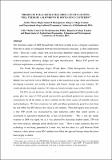| dc.description.abstract | The food price spikes of 2008 showed that world food security is not a foregone conclusion.
With this in mind, we distinguish between three productivity measures, as their implications
differ. These are: yields, which, with area harvested, determine output; labour productivity,
which correlates with incomes; and total factor productivity, which distinguishes between
technical progress, efficiency change and input intensification. Hence TFP growth has
different implications, according to its cause.
The World Development Report (World Bank, 2008) distinguishes between the
agriculture-based, transforming, and urbanised countries that constitute agriculture’s three
worlds. The first is dominated by Sub-Saharan Africa (SSA), with much of Asia and the
Middle East and North Africa (MENA) region in the transitional group, while and urbanised
developing economies are mostly in Eastern and Central Europe and Latin America. We
would add the developed countries (DCs) that are loosely member states of the OECD.
The DCs are not the focus, but the slowing of public agricultural R&D growth in this
group, plus low rates of GDP growth and possibly agricultural productivity measures, have
connotations for all the others, as these countries are the initial source of scientific advances
and technologies. We find a tendency for yield and labour productivity growth to slow from
the mid 1980s, but TFP did not slow down in all countries. What did happen more generally,
is that TFP growth was maintained by input reduction, rather than output growth, as
investment in agriculture declined due to lack of profitability. This is why the supply
response in 2008 was rapid, but as it was achieved by increasing modern inputs, TFP will
have been reduced, although yields should have risen. There is some consensus that new
technology is not being generated as it once was, but here there is a gulf between North
America, where private sector GM varieties have filled the gap and Europe where they have
been largely excluded.
If there is less technology internationally available from the world’s leading national
agricultural research stations (NARS), the effect on the urbanised countries may not be great.
The Eastern and Central European countries have to long way to go to increase efficiency
levels to match Northern Europe, so reorganisation matters more than technical progress. In
Latin America, countries like Brazil and Argentina are industrialising and commercialising
agriculture and have their own research capacity that may well increase yields as a result.
They are almost certain to increase labour productivity as agriculture is mechanised and TFP
should be driven by labour productivity growth.
For the upper end of the transforming countries the same is true, as China and India
have the research capacity to generate yield growth and the withdrawal of labour from
agriculture will raise labour productivity and TFP. It is the smaller countries, with less
research capacity and less industrialisation that may be at risk from productivity stagnation if
they do not attract private technology providers.
The agriculture-based countries range from the small failed states of SSA to
countries like Kenya, which has quite reasonable research capacity. All the TFP studies
show that SSA lags behind, but that productivity has been improving since the mid 1980s.
The key seems to be institutions, incentives and better policy and infrastructure. It is
efficiency change, rather than new technology and SSA could have reasonable growth in TFP
and yields on this basis alone. A major difference between Asia and Africa is that in Asia,
yield growth has been translated into increased labour productivity and better incomes. In
SSA, yield increases have improved labour productivity very little, so there is a difficult
question as to whether the relatively land abundant countries can follow a path of labour
saving technical change.
The unknowns that will determine the future course of agricultural development centre
around energy and climate change. With the oil price at below $40 per barrel, the biofuels
industry is not currently a problem, but once the recession is over the issue of food versus fuel
will reappear. Agriculture will need to adjust to more expensive fertiliser, fuel and transport,
while pushing towards sustainability and lower environmental costs. It remains to be seen
how energy efficient technologies can be developed with lower public R&D growth and with
many countries still avoiding any science that includes GM. | en |


